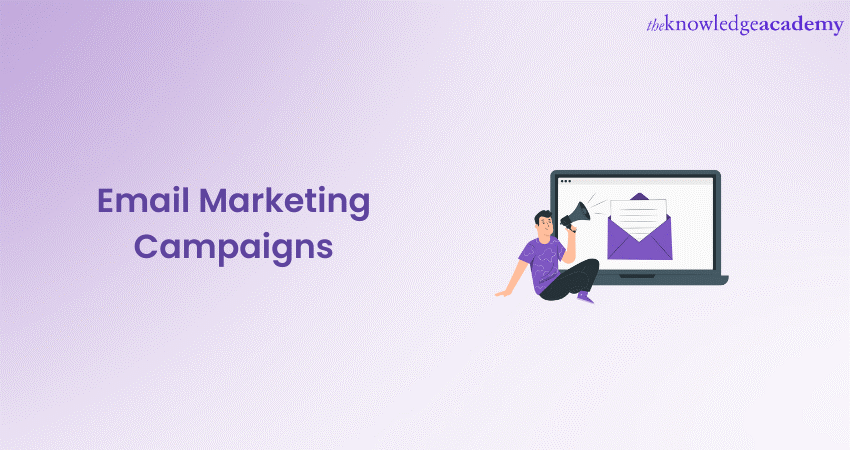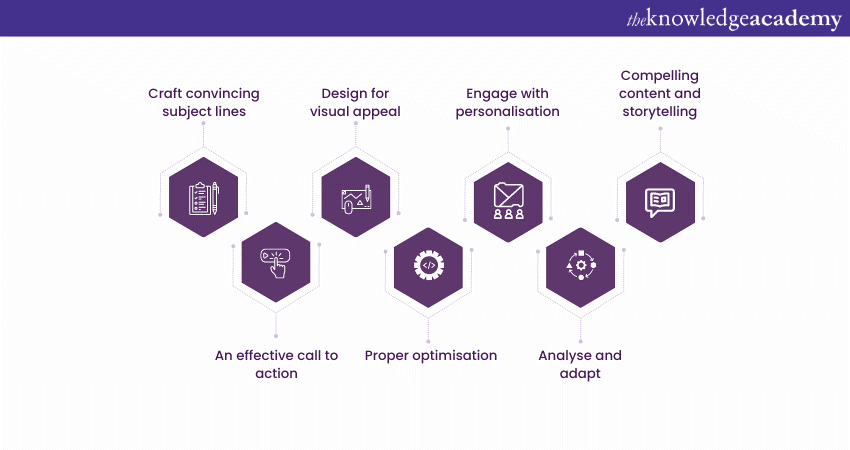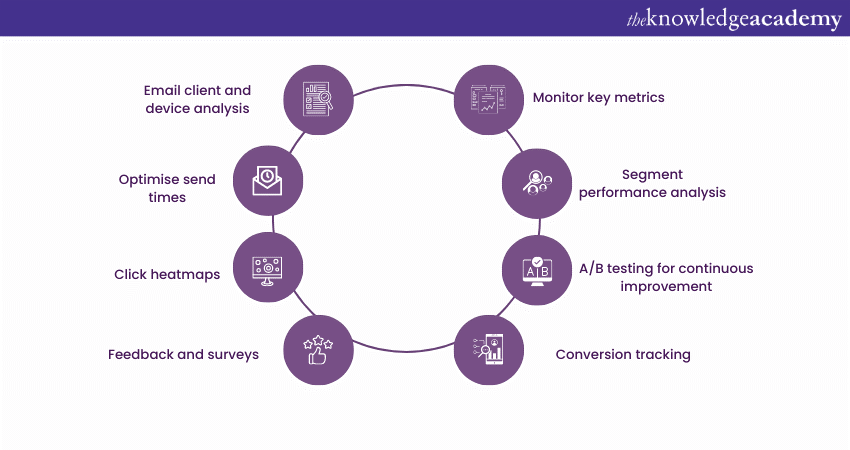We may not have the course you’re looking for. If you enquire or give us a call on +1 6474932992 and speak to our training experts, we may still be able to help with your training requirements.
We ensure quality, budget-alignment, and timely delivery by our expert instructors.

With the power to reach vast numbers of individuals directly in their inboxes, Email Marketing Campaigns are powerful marketing tools. They offer a unique opportunity to establish meaningful connections, share valuable content, and propel recipients toward desired actions.
According to Statista, 50 per cent of marketing professionals reported doubling their Return on Investment (ROI) due to effective Email Campaigns. This highlights the significance of this potent marketing channel, and if you are interested in knowing more about Email Marketing, then this blog is for you. In this blog, you will learn what Email Marketing Campaigns are, their different types, top strategies as well as how to create the best campaigns.
Table of Contents
1) Understanding Email Marketing Campaigns
2) Different types of Email Marketing Campaigns
3) Strategies for top Email Marketing Campaigns
4) Creating the best Email Marketing Campaigns
5) Measuring and optimising Email Marketing Campaigns
6) Conclusion
Understanding Email Marketing Campaigns
Email Marketing Campaigns are structured series of emails sent to a targeted audience with a specific goal in mind. They range from promotional offers and product launches to informational newsletters and customer engagement initiatives. These campaigns enable businesses to engage with their subscribers over time, nurturing them through the buyer's journey.
Different types of Email Marketing Campaigns
Marketing campaigns encompass a range of strategies that businesses employ to engage their audience, foster relationships, and drive conversions. Among these strategies, the types of Email Marketing play a crucial role in ensuring effective communication with customers. Understanding the diverse types of campaigns available allows marketers to tailor their efforts and maximise results. Here are several effective Types of Email Marketing Campaigns:

1) Promotional campaigns: These campaigns focus on driving immediate action by offering recipients exclusive deals, discounts, or time-sensitive offers. They create a sense of urgency that encourages subscribers to make purchases.
2) Welcome series: When someone subscribes to your email list, a well-crafted welcome series can make a lasting impression. Send a sequence of emails introducing your brand, values, and products, setting the stage for a fruitful relationship.
3) Educational newsletters: Position your brand as an industry authority by sending newsletters filled with valuable content. Share insights, tips, how-to guides, and educational resources that resonate with your audience's interests.
4) Abandoned cart emails: Abandoned cart emails remind clients of stuff left in their online shopping carts. These reminders often come with incentives, nudging customers to complete their purchases and recover potential revenue.
5) Re-engagement campaigns: Target inactive subscribers with compelling content, special offers, or incentives to reignite their interest. These campaigns help maintain a healthy subscriber list and improve overall engagement.
6) Product recommendations: Leverage data to suggest products based on a subscriber's past purchases or browsing behaviour. Personalised recommendations enhance the shopping experience and drive additional sales.
7) Event invitations: If you're hosting webinars, workshops, or other events, email invitations are a powerful way to attract attendees. Provide event details, benefits of participation, and clear calls to action (CTA).
8) Announcement campaigns: Keep subscribers informed about important company news, product launches, updates, or milestones. This helps maintain a connection with your audience and builds anticipation.
9) Survey and feedback campaigns: Engage with your audience by looking for their opinions through surveys and feedback forms. This interaction not only builds rapport but also provides insights for refining your offerings.
10) Social proof campaigns: Share user-generated content, testimonials, reviews, and case studies in your emails. Social proof enhances trust, validating your products or services in the eyes of potential customers.
Incorporating these types of campaigns into your Email Marketing strategy allows you to target specific objectives and segments of your audience. Whether it's boosting sales or enhancing engagement, the diversity of campaign options lets you connect with subscribers at various stages. Remember, successful Email Marketing involves understanding your audience, crafting compelling content, and continuously optimising your campaigns for the best results.
Strategies for top Email Marketing Campaigns
Employing effective strategies can be the linchpin that propels your campaigns to new heights of engagement and success. In order to captivate your audience and achieve remarkable results, consider these top Strategies for Email Marketing Campaigns:
1) Segmentation for personalisation: Divide your subscriber list into segments based on demographics, behaviours, or preferences. Tailoring content to each segment's interests boosts relevance and engagement.
2) Compelling content creation: Craft content that informs, entertains, or solves problems for your audience. Valuable content builds trust and keeps recipients eager to open your emails.
3) Strategic call to action (CTA): Use clear, concise CTAs that guide recipients toward a specific action, such as making a purchase or signing up. Make CTAs visually distinct to encourage interaction.
4) Mobile optimisation for accessibility: Design emails with a mobile-responsive layout to ensure they display correctly on various devices. Mobile-friendly emails cater to the growing number of mobile users.
5) Automated workflows for engagement: Set up automated email sequences for tasks like welcoming new subscribers, nurturing leads, or recovering abandoned carts. Automated workflows streamline communication and improve conversions.
6) Data-driven insights: Analyse metrics like open rates, click-through rates, and conversion rates to comprehend campaign performance. Use this data to fine-tune strategies and content.
7) Testing and refinement: Test different elements, such as subject lines, visuals, or sending times, to identify what works best with your audience.
By integrating these strategies into your Email Marketing approach, you can create campaigns that engage, convert, and build lasting connections with your audience.
Elevate your outreach game and captivate audiences with our Email Marketing Training. Sign up now!
Creating the best Email Marketing Campaigns
Crafting an Email Marketing Campaign that truly resonates with your audience and delivers remarkable results requires following a few key best practices. Here are some essential strategies to create the best Email Marketing Campaigns:

1) Craft convincing subject lines: The subject line is your first chance to grab the recipient's attention. Craft a subject line that's intriguing, concise, and relevant to the content inside. Personalisation and curiosity can work wonders here.
2) Design for visual appeal: Your email's design should be visually pleasing and aligned with your brand. Use a clean layout, easy-to-read fonts, and complementary colours. Visual elements should enhance the message, not overwhelm it.
3) Engage with personalisation: Personalisation goes beyond just adding the recipient's name. Use segmentation and dynamic content to tailor the message to each subscriber's interests, preferences, and behaviour.
4) Compelling content and storytelling: Your email's content should be engaging, valuable, and easy to consume. Incorporate storytelling to make an emotional connection with people and make your brand more relatable.
5) An effective call to action: Every email should have a clear and prominent CTA that guides the recipient toward the desired action. Use action-oriented language, such as "Shop now" or "Learn more," and ensure the CTA stands out visually.
6) Proper optimisation: Experiment with different elements, such as subject lines, CTAs, visuals, and sending times. A/B testing allows you to find which variations resonate best with your audience and refine your approach.
7) Analyse and adapt: Regularly monitor and analyse key performance metrics like open rates, click-through rates (CTR), and conversions. Use these insights to adapt your strategies and continually improve your campaigns.
By implementing these approaches, you can create Email Marketing Campaigns that not only capture attention but also drive conversions. Remember, the key lies in understanding your target audience, delivering value, and maintaining a focus on continuous improvement.
Measuring and optimising campaigns
Measuring the victory of your Email Marketing Campaigns is essential for refining your strategies and achieving better results over time. By analysing key metrics and making data-driven decisions, you can continually optimise your campaigns to improve engagement and conversions. Here are some tips for measuring and optimising your Email Marketing Campaign:

1) Monitor key metrics: Maintain a close eye on metrics like open rates, click-through rates (CTR), conversion rates, and unsubscribe rates. These metrics provide insights into how well your campaigns are resonating with your audience.
2) Segment performance analysis: Break down your metrics by different audience segments to understand which groups are responding most positively to your campaigns. This segmentation helps tailor your content and strategies for better results.
3) A/B testing for continuous improvement: Perform A/B tests on various components of your emails, such as subject lines, CTAs, visuals, and content. Comparing the performance of different versions allows you to identify what resonates best with your audience and make data-backed decisions.
4) Conversion tracking: Implement tracking mechanisms to monitor the actions recipients take after clicking through to your website. Tracking conversions, whether it's making a purchase, signing up, or downloading content, gives you a clear picture of your campaign's impact on your bottom line.
5) Feedback and surveys: Seek feedback from your subscribers through surveys to understand their preferences, expectations, and pain points. This qualitative data can provide insights into how to better tailor your campaigns to your audience's needs.
6) Click heatmaps: Analyse click heatmaps to see where recipients are engaging with your emails the most. This helps you identify the most clickable areas and optimise your layout for a better user experience (UX).
7) Optimise send times: Pay attention to the times and days when your emails generate the highest engagement. Experiment with different timings to determine when your audience is most receptive to your messages.
8) Email client and device analysis: Understand which service and devices your subscribers are using to open your emails. This insight can guide your design and layout decisions, ensuring your emails look great across various platforms.
Using insights for optimisation
Once you've gathered enough data and insights, it's time for optimising your Email Marketing Campaigns. Here’s how you can achieve that:
1) Refine content and design: Adjust your content, visuals, and layout based on what resonates with your audience. Emphasise elements that receive high engagement and adjust or remove those that aren't performing well.
2) Personalisation and segmentation: Leverage the insights from segment analysis and A/B testing to personalise your campaigns for different audience segments. Deliver content that speaks straight to their interests and needs.
3) Iterative approach: Use an iterative approach by implementing changes gradually and measuring the impact. This prevents drastic shifts that might confuse your audience and allows you to fine-tune your campaigns effectively.
4) Continuous learning: Keep learning from your data, and stay informed on the industry trends and best practices. Email marketing is a dynamic field, and staying informed helps you adapt to changing preferences and behaviours.
5) Staying agile in a dynamic landscape: Navigating the world of Email Marketing demands a nimble approach. Analysing your data-driven insights empowers you to make informed decisions that lead to enhanced engagement, conversions, and overall campaign success. The marriage of data and strategy propels your campaigns from static to dynamic, ensuring they resonate with your audience's ever-changing expectations.
6) Strategic evolution for lasting impact: Remember, the process of measuring and optimising your Email Marketing Campaigns isn't a one-time effort, but rather an ongoing journey. Applying data-driven insights and adhering to industry best practices empowers you to fine-tune your approach, create more engaging campaigns, and ultimately achieve lasting success in your Email Marketing endeavours.
Measuring and optimising your Email Marketing Campaigns is a dynamic process that involves careful analysis, experimentation, and refinement. By using data-driven insights and applying best practices, you can enhance engagement, conversions, and overall success in your Email Marketing efforts.
Transform your marketing budget management with our Marketing Budget Masterclass. Sign up now!
Conclusion
We hope you read and understand Email Marketing Campaigns. Even in this fast-paced world, it still remains a potent avenue. Employing personalised content and data-driven insights can foster engagement and drive more conversions. This will solidify Email Marketing's role as a cornerstone for successful modern marketing strategies.
Equip yourself for marketing mastery with our Marketing Training. Sign up today!
Frequently Asked Questions
Upcoming Digital Marketing Resources Batches & Dates
Date
 Email Marketing Course
Email Marketing Course
Fri 11th Apr 2025
Fri 13th Jun 2025
Fri 8th Aug 2025
Fri 26th Sep 2025
Fri 21st Nov 2025






 Top Rated Course
Top Rated Course



 If you wish to make any changes to your course, please
If you wish to make any changes to your course, please


